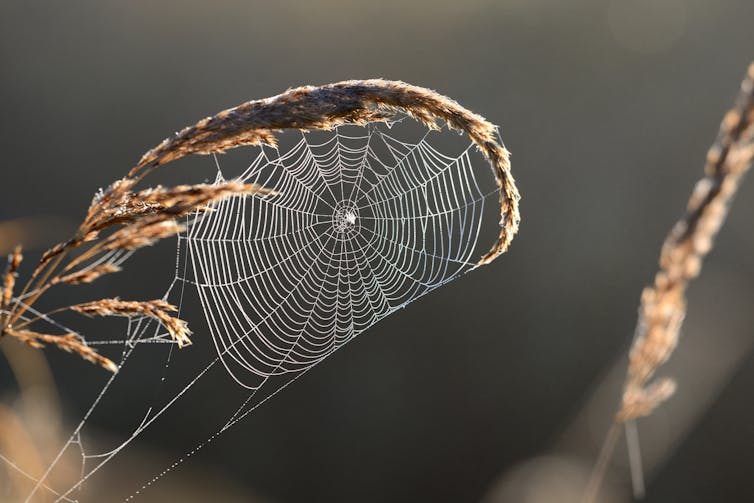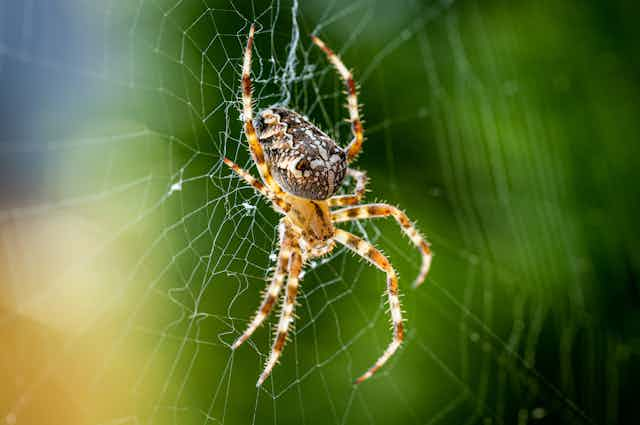Really, we should envy spiders. Imagine being able to make silk like they do, flinging it around to get from place to place, always having a strong-as-steel safety line or spinning a comfy hammock whenever they need a rest.
The fascinating properties of spider silk make it no wonder that scientists have been trying to unravel its secrets for decades.
If we could understand and recreate the spinning process, we could produce artificial spider silk for a range of medical applications. For example, artificial silk can help regenerate the nerves that connect our brain and limbs, and can shuttle drug molecules directly into the cells where they are needed.
Spider silk is made of proteins called spidroins, which the spider stores in a silk gland in its abdomen. There are several types of spidroin for spinning different sorts of silk. Spiders store them as a liquid that resembles oil droplets.
But one of the questions that has eluded scientists so far is how spiders turn these liquid droplets into silk. We decided to investigate why the spidroins form droplets, to get us closer to replicating a spider’s spinning process.
Weaving a web
The trick that spiders use to speed up their spinning process can be used to spin better artificial silk, or even develop new spinning processes.
In 2017, we learned to make synthetic silk fibres by emulating the silk gland, but we did not know how things work inside the spider. Now we know that forming droplets first speeds up the conversion to these fibres.
An important clue to how the droplets and fibres are related came from an unexpected area of our research – on Alzheimer’s and Parkinson’s diseases. Proteins that are involved in these diseases, called alpha-synuclein and tau, can assemble into tiny, oil-like droplets in human cells.
Tau is a protein that helps stabilise the internal skeleton of nerve cells (neurons) in the brain. This internal skeleton has a tube-like shape through which nutrients and other essential substances travel to reach different parts of the neuron.
In Alzheimer’s disease, an abnormal form of tau builds up and clings to the normal tau proteins, creating “tau tangles”.
Alpha-synuclein is found in large quantities in dopamine-producing nerve cells. Abnormal forms of this protein are linked to Parkinson’s disease.

Oil droplets of either one of these proteins form in humans when they become entangled, like boiled spaghetti on a plate. At first, the proteins are flexible and elastic, much like spidroin oil droplets.
But if the proteins remain entangled, they get stuck together which alters their shape, changing them into rigid fibres. These can be toxic to human cells – for example, in neurodegenerative conditions such as Alzheimer’s.
However, spidroins can form droplets too. This left us wondering if the same mechanism that causes neurodegeneration in humans could help the spider to convert liquid spidroins into rigid silk fibres.
To find out, we used a synthetic spidroin called NT2RepCT, which can be produced by bacteria. Under the microscope, we could see that this synthetic spidroin formed liquid droplets when it was dissolved in phosphate buffer, a type of salt found in the spider’s silk gland. This allowed us to replicate spider silk spinning conditions in the lab.
Silky science
Next, we studied how the spidroin proteins act when they form droplets. To answer this question, we turned to an analysis technique called mass spectrometry, to measure how the weight of the proteins changed when they formed droplets. To our surprise, we saw that the spidroin proteins, which normally form pairs, instead split into single molecules.
We needed to do more work to find out how these protein droplets help spiders spin silk. Previous research has shown spidroins have different parts, called domains, with separate functions.
The end part of the spidroin, called c-terminal domain, makes it form pairs. The c-terminal also starts fibre formation when it comes into contact with acid.
So, we made a spidroin which contained only the c-terminal domain and tested its ability to form fibres.
When we used phosphate buffer to entangle the proteins into droplets, they turned into rigid fibre instantly. When we added acid without first making droplets, fibre formation took much longer.
This makes sense since the spidroin molecules must find each other when forming a fibre. Entangling the spidroins like spaghetti helps them rapidly assemble into silk.
This finding tells us how the spider can instantly convert its spidroins into a solid thread. It also uncovered how nature uses the same mechanism that can make brain proteins toxic to create some of its most amazing structures.
The surprising parallel between spider silk spinning and fibres toxic to humans could one day lead to new clues about how to fight neurodegenerative disorders.
Scientists may use spider silk research, including what we have learned about the spider silk domains, to keep human proteins from sticking together – to stop them from becoming toxic. If spiders can learn how to keep their sticky proteins in check, perhaps so can we.

